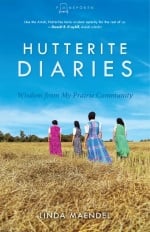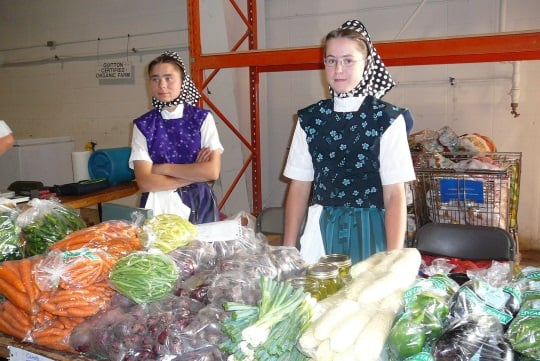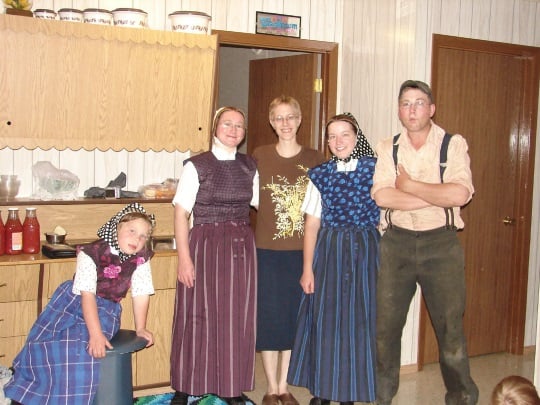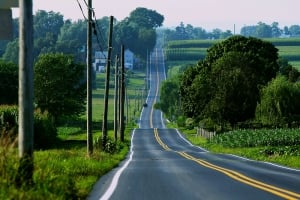Hutterite Clothing
 How do Hutterites dress? How does Hutterite clothing compare to that of the Amish? What are the differences in clothing across the three Hutterite groups?
How do Hutterites dress? How does Hutterite clothing compare to that of the Amish? What are the differences in clothing across the three Hutterite groups?
On our recent Hutterite questions post, some of you were curious about Hutterite clothing. Hutterite Diaries author Linda Maendel answers these questions and more in today’s post.
—
Hutterite Dress
Hutterites, like the Amish, dress modestly. As you can see on the cover of my book, women and girls wear long dresses with a blouse underneath it. The head covering for women is a black Tiechl, similar to a kerchief. School girls wear bonnets that may be of any colour, most often these match the dress.

Men wear dark trousers, button-down plaid or plain cotton shirts and suspenders. Some men wear a hat but in many colonies that is not a requirement. Most clothes are homemade, as Hutterite women are exceptional seamstresses. Besides clothes they also sew beautiful quilts, bedding and curtains.
In regards to how Hutterite dress compares to that of the Amish, I’d say, they both dress modestly, but Hutterite women tend to wear darker coloured dresses. The dress patterns or style is somewhat different as well. And where the Amish women wear a bonnet for a head covering, Hutterites wear a Tiechl, as mentioned above.

Since their Anabaptist beginnings in sixteenth century Europe, Hutterites have practised a modest, simple and uniform dress code. The early traditional style originates from the German and Austrian national costume: black Lederhosen and suspenders for men and boys; the Dirndl, a sleeveless dress with a blouse and an apron for women and girls.
Over the years, Hutterites have modified these to make them more serviceable and comfortable. In addition to its value as a cultural tradition, this outward symbol of unity and modesty is an integral part of their faith life, identifying and reminding them who they are as a people.

There are three distinct groups of Hutterites: Dariusleut, Lehrerleut and Schmiedenleut, each adhering to its own variations of this dress code. Of the three groups, the Schmiedenleut are the more progressive and the Lehrerleut the most conservative.
Similarities among the groups include blouses and ankle-length dresses, along with a Tiechl, head kerchief for women; dark trousers and suspenders for men. Both men and women usually wear dark jackets/coats. Children, for the most part wear lighter colours than adults, and in all three groups, young girls wear a head covering known as a Mitz, cap or bonnet.

Dariusleut: Men’s jackets are collarless and Dariusleut men are more prone to wear a hat. The women’s two-piece dress with elbow-length sleeves is relatively dark, and they wear an apron of the same fabric as the dress. Their Tiechl is black with tiny white dots. Boys wear a black homemade cap, a Katuss.
Lehrerleut: Men are dressed similarly to the Dariusleut. Women’s sleeveless dresses are somewhat lighter with an even lighter, usually plaid apron. The huge polka dots of their stiffly starched Tiechl makes it appear almost white.
Schmeidenleut: The major difference between the men of this group and the other two is that they wear many types of mostly dark- coloured casual jackets. Men’s suit jackets are similar to that of any non-Hutterite suit jackets, and in most cases homemade. Women wear either a two-piece or one-piece dress, according to preference. The Tiechl is mostly plain black. In some colonies women wear a sheer black apron to church services, though, most have eliminated it.

Of importance is that particular dress styles are cultural traditions, and for Hutterites, the goal is modest, simple clothing in uniform style, according to each Leut’s, or conference Church ordinances.
Dressing differently from mainstream society is as much a part of Hutterianism as living communally – fostering a sense of belonging to a much larger whole – in spirit of the New Testament teaching, that exhorts believers to strive for the “inner beauty” that produces a wealth of good works (1 Peter 3). This is a testimony that not only benefits others, but pleases and honours God.

While the three groups dress differently, and also have other differences such as the day-to-day operation of the colony, they all live communally. We also speak the same language, practice the same faith, use the same sermons written by our forefathers, and share the same history. There is some contact between the groups as well, through visits, phone calls and electronic connections.
Flickr images: Lethbridge Market- page_eliz; Sage Creek- Teresa; Lehrerleut children & Laundry- Roger; Hutterite men, Morinville Colony- Marcia O’connor







Hutterite Clothing
Am I correct in thinking that there is still a very East European influence in the clothing style? There are some similarities to what I would call the old Russian Mennonite clothing, that which might be worn by the more conservative Mennonites in Mexico. But in all plain dress styles, whether Amish, Mennonite or Hutterite, the main concern is modest and uniform dress which is influenced by the cultures out of which we came many years ago.
yes, your observation of an eastern european style to hutterite clothing is correct
yes, your observation of an eastern european style to hutterite clothing is correct.
the hutterite path moved from germanic central europe toward eastern europe. the hutterites were living in western Russia by the time they picked up and moved to north america en masse.
closures?
I was trying to see in the pictures, but it looks like the closures on the clothing (particularly men) are more “English”, with a button and fly versus the “barn door” buttons on Amish pants. Also, are the dresses/blouses pinned as some Amish do, or are buttons used?
No, Hutterite dresses are not pinned, snaps or buttons are used.
What is modest?
They use the term ‘modest’ to mean that the clothing covers the persons body more. Some might say the colors they use on the cloth are not modest compared to the Amish dark clothing.
>>>In regards to how Hutterite dress compares to that of the Amish, I’d say, they both dress modestly, but Hutterite women tend to wear darker coloured dresses.<<<
I think they meant to say "but Amish women tend to wear darker coloured dresses." At least the Amish women I have met wear dark clothing.
Tom Geist
Tom Geist.. most of the Amish women I see are wearing bright colors in Geauga Co.. Usually a light blue, purple, pink, and aqua are very common colors around here.. The much older ladies do tend to wear black though I’ve seen them in the bright colors as well on occasion.
Jumpers?
You might call them sleeveless dresses with a blouse underneath. To me, they’re JUMPERS (which are worn with blouses or other “tops” underneath.) Yes? No?
In grade school, our uniform consisted of a navy blue jumper with a white blouse underneath.
I still have, and wear, jumpers.
The patterned & plaid colorful fabrics are quite striking for a “plain” community. They’re certainly distinctive & cheerful-looking!
And men can wear full beards (with moustache)? Or does it differ with various groups?
Yes, Alice, I suppose you could call that type of dress, jumper. For us,though, they’re simply a dress, just like the two-piece style, with a top and separate skirt, is also known as dress.
Yes, many men wear full beards.
....
This is such a nice post and I really like your post, Thanks for sharing this post with us, you are amazing in your work. Keep it up.
Your work is really good and I appreciate this information. I forever prefer to read quality and glad I found this thing in your post. Thank you for the comprehensive article.
looks great and very fabulous thanks for sharing great thoughts